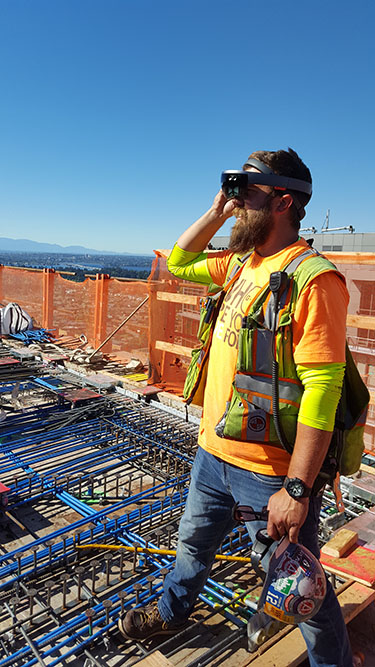|
Subscribe / Renew |
|
|
Contact Us |
|
| ► Subscribe to our Free Weekly Newsletter | |
| home | Welcome, sign in or click here to subscribe. | login |
Construction
| |
 |
May 5, 2017
Tech wizardry: What’s really behind the curtain?
GLY Construction

Herb
|
The 1.5 million-square-foot Lincoln Square expansion is one of the largest private development projects in Bellevue’s history. GLY has been around the block a few times, literally, but even for us the sheer size and scale of the project demanded we question all our previous assumptions and processes.
With up to 1,100 people per day (equivalent to $825,000 in payroll) working to erect 13 million pounds of structural steel, hang 550,000 square feet of curtain wall, and install 330,000 lineal feet of piping — all while the clock ticks down to leasable space generating income for our client — the consequences of inefficiency are potentially astronomical.
What are we trying to solve?
Everything we do is centered on one key question: How do we reduce waste and create efficiency? This isn’t just an economic consideration, although that’s an important driver. It’s about reducing the burden on our employees so that they can do their best work safely, effectively and without undue stress.
There are five key issues that can compromise efficiency on a project:
1. Motion: excessive walking to accomplish a task. Throw in the need to cross a street with traffic lights on a 7-minute signal and you do the math!
2. Delivery and storage. Poorly timed deliveries wreak havoc on a jobsite, creating a chain reaction of multiple moves to store materials.
3. Excess inventory gets in the way of production and clutters the site, compromising safety.
4. Waiting for information, materials, equipment, etc. to arrive.
5. Defects, mistakes and rework.
We have incredible technology that helps us do our job more efficiently, such as virtual and augmented reality and 3-D design models. They allow us to visualize space before it is built, test fit systems and structures in half-constructed rooms, and create interactive models to identify optimum solutions. But at the end of the day, it’s not the technology itself that transforms the way we build, but how people understand, apply and leverage it.
Knowing what, forgetting how
The benefits of using augmented reality and virtual reality to visualize space are well documented, but the user must understand what they’re looking at and know which actions to take next. On the Lincoln Square expansion project, we developed a comprehensive 3-D model in Revit with key subcontractors. This effort is self-performed by GLY project engineers, a process we’ve been refining for over 10 years now.
The main intent of the model is to find conflicts, resolve dimensions, and develop highly accurate shop drawings so we know exactly what to build; but if you focus solely on determining what to build, you miss the opportunity to leverage thinking about how to build it. The process becomes inherently wasteful because you’re just reacting to the environment.
Instead, we engage our superintendents in developing a comprehensive construction schedule informed by the model. All five of our superintendents on this project contributed their thoughts and plans, and then we incorporated this information into the model to create a 4-D time lapse representation of the construction process.
The model is only ever as good as the information that goes into it. With this level of detail we were able to tune up the sequence to streamline one comprehensive, coordinated construction effort.
Physical, virtual distance
Minimizing the physical distance people and materials have to travel is one challenge; the other is the virtual distance between getting information from the job office into the field. The speed of electronic distribution and the highly visual capability of digital communication is unquestionably efficient.
Smartphones and tablets allow us to send large data files to teams quickly, even though we have to overcome the lack of Wi-Fi and often very weak cell phone coverage. This efficiency of communication means fewer errors, because everyone can access vital new information at the touch of a button.
Nonetheless it does have a bit of a downside: We don’t want our crew glued to their screens while they’re walking across the jobsite. We consider it equivalent to texting while driving. The impact of a distracted pedestrian on a downtown sidewalk is bad enough, but where there is heavy machinery, multiple obstacles, and an ever-changing hazardous environment, the consequences can be serious not only for the individual but for the safety of the entire team.
We have to train and reinforce safe behavior, and that includes adjusting to new technologies. These ongoing discussions at the jobsite level are really the only counter to the advantages.
Powerful tools in the right hands
We are reaping the benefits of new and emerging technologies on a daily basis and everyone from our field crews to our integrated design engineers are constantly evolving new applications and new ways to optimize available and emerging technologies. From spherical cameras that give us a 360-degree view of a room’s status at any given moment, to a FARO laser that allows us to quickly scan and measure an existing space in 3-D (imagine an incredibly accurate as-built document), we have so many more opportunities to evolve our approach.
However, our philosophy remains unchanged. Technology is a tool, an increasingly powerful tool, but unless it is in trained hands and adds real value it is at best a toy. Technology cannot replace careful planning, the deep insight that comes from experience, and a friendly crew member looking out for the safety of their teammates and neighborhood residents.
The real magic happens when you combine the two. In the right hands these innovations do more than just reduce waste and create efficiency, they engender conversations that are more coordinated and meaningful. They empower people to be effective and in control of the myriad moving parts that need to come together for successful execution of complex projects. Technology does not replace careful planning, it enhances it, allowing us to see more, do more, and tackle problems in a new way.
Ted Herb is president at Bellevue-based GLY Construction, one of the region’s largest locally owned contractors, currently celebrating 50 years in business.
Other Stories:
- ABC mantra: Get into politics or get out of business
- Institutional Construction
- Historic Preservation/Restoration
- Electrical Construction
- Mechanical Construction
- Specialty Contracting: Exterior
- Survey: Stoneway Concrete
- Survey: Colvos Construction
- Survey: Compass General Construction
- Survey: Rafn Co.
- Survey: GLY Construction
- Multifamily Construction
- Tenant Improvement/Renovation
- 10 things developers must consider when hiring a GC
- Time to put the brakes on 700 work zone deaths
- Equipment firms’ new focus: ‘power-by-the-hour’
- What every contractor should know about bonds
- Eagle of Excellence • Mixed-Use Construction
- Commercial Construction over $10 million
- Commercial Construction $1 million to $5 million
- Commercial Construction under $1 million
- Community & Public Service
- Healthcare
- Survey: PCL Construction Services



